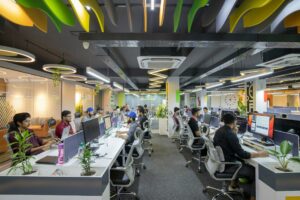Digital Twins: How They Are Changing Cities, Factories, and Healthcare

Digital Twins: How They Are Changing Cities, Factories, and Healthcare
What Exactly Are Digital Twins?
A digital twin is a virtual representation of a physical item, process, or system that is created to duplicate its real-world counterpart in real time. Digital twins make it possible for enterprises to keep an eye on performance, make predictions about it, and enhance it by integrating data analytics, simulation, and sensors. What started off as an idea for aircraft engineering has now grown into a variety of other sectors, influencing the way in which we develop, manage, and improve complex systems.
The Increase in Popularity of Digital Twins in the Year 2025
Digital twins are becoming more readily available and more powerful as a result of advancements in connection, cloud computing, and artificial intelligence. They are no longer being seen as experimental tools by industries but more as critical components of the process of digital transformation. Digital twins are making their way out of factories and into cities, healthcare systems, and people’s daily lives by the year 2025.
Smart Cities and Urban Planning
Digital twins are transforming the way in which infrastructure is built and maintained in the field of municipal administration. Digital simulations of whole metropolitan districts may be created, which enables authorities to experiment with solutions to traffic flow, find ways to optimize energy use, and make plans for resilience in the face of climate change. Digital models are able to develop together with the city because to the real-time data that is collected from sensors and Internet of Things (IoT) devices. This makes it possible to respond to catastrophes in a more intelligent manner and develop plans for long-term sustainability.
Factories and Efficiency in Industry
Of all the industries that stand to benefit from the use of digital twin technology, manufacturing is still one of the greatest. These systems are used in factories to model production processes, forecast equipment breakdowns, and reduce downtime. Managers are able to save time and save expenses by using digital copies to evaluate changes before putting them into effect. Digital twins, when used in conjunction with predictive maintenance, are assisting industries as they make the shift to operations that are more intelligent and productive.
Healthcare and Patient Care
The healthcare industry is becoming one of the industries that is most likely to be transformed by the use of digital twins. Medical diagnosis, treatment planning, and customized medicine are all applications that may benefit from the use of virtual representations of human organs, bodily systems, or even complete patients. Researchers are able to utilize digital twins to try out novel treatments without putting patients in danger, while surgeons are able to replicate operations before they enter the operating room. The combination of data and biology is helping to drive the healthcare industry in the direction of accuracy and prevention.
Energy and Sustainability
Energy firms are increasingly embracing digital twins to improve power grids, renewable energy systems, and resource distribution in addition to industries and hospitals. Digital twins assist in the reduction of waste and the improvement of sustainability by modeling supply and demand in real time. This technology makes certain that the infrastructure is able to adjust to new requirements without any issues as communities continue to make efforts to transition to green energy.
The Function of Artificial Intelligence
The analysis of huge volumes of data and the identification of patterns that people would overlook are two ways that artificial intelligence improves digital twins. Predictive skills, such as the ability to anticipate traffic congestion, industrial problems, or patient health hazards, are made possible by simulations that are powered by artificial intelligence. Digital twins are more than simply static models due to this synergy; they evolve into dynamic systems that are capable of learning and adapting.
Benefits That Are Available in a Variety of Industries
Monitoring in Real Time: Keeps track on performance and detects problems as soon as they arise.
- Predictive analytics is a technique that is used to anticipate issues before they really happen.
- Cost Savings: Minimizes waste and avoids expensive downtimes from occurring.
- Sustainability: Uses resources in the most efficient manner possible in order to make operations more environmentally friendly.
- Personalization: Allows for solutions that are personalized to the specific needs of each patient in healthcare and customer service.
Difficulties Encountered During the Adoption Process
Digital twins, despite the potential they hold, encounter obstacles. Ethical issues are brought to the forefront by the privacy of data, especially in the healthcare industry. For smaller firms, the cost of deployment and integration with old systems might be prohibitive. Furthermore, the creation of correct digital models demands a significant quantity of dependable data, which is something that not every industry has the resources to collect.
What the Future Holds
Digital twins are anticipated to become a conventional component of smart infrastructure on a global scale by the year 2030. They will be used by cities to adapt to the changing environment, by companies to achieve hyper-efficient production, and by healthcare providers to provide life-saving precision therapies. As technology continues to evolve, the ability for systems to operate in conjunction with one another will be essential. This will enable digital twins in many industries to collaborate and function together without any issues.
Digital twins are no longer considered to be future experiments; they are already actual instruments that are being used to reshape businesses in real time. They are closing the gap between the real and digital worlds by implementing a variety of solutions, ranging from personalizing health care to making cities more intelligent and manufacturing more efficient. Despite the fact that obstacles persist, the possibility for transformation that they provide is evident, which has led to digital twins being an essential component of innovation in the years to come.




